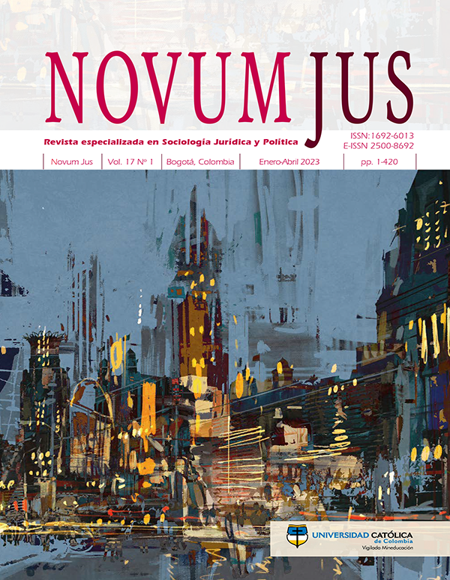
Esta obra está bajo una licencia internacional Creative Commons Atribución-NoComercial 4.0.
Aquellos autores/as que tengan publicaciones con esta revista, aceptan los términos siguientes:
- Los autores/as conservarán sus derechos de autor y garantizarán a la revista el derecho de primera publicación de su obra, el cuál estará simultáneamente sujeto a la Licencia de reconocimiento no comercial de Creative Commons que permite a terceros compartir la obra siempre que se indique su autor y su primera publicación esta revista.
- Los autores/as podrán adoptar otros acuerdos de licencia no exclusiva de distribución de la versión de la obra publicada (p. ej.: depositarla en un archivo telemático institucional o publicarla en un volumen monográfico) siempre que se indique la publicación inicial en esta revista.
- Se permite y recomienda a los autores/as difundir su obra a través de Internet (p. ej.: en archivos telemáticos institucionales o en su página web) antes y durante el proceso de envío, lo cual puede producir intercambios interesantes y aumentar las citas de la obra publicada. (Véase El efecto del acceso abierto).
Resumen
El fomento de las actividades creativas, científicas, innovadoras y de la competencia empresarial depende en gran medida de la protección sólida de la propiedad intelectual y los derechos asociados en internet. El problema de esta protección radica en la naturaleza transnacional de internet, en la ausencia de una administración unificada y centralizada, en la dificultad de probar una violación de los derechos, y en la falta de regulación. Este artículo analiza las características de la protección de los derechos de propiedad intelectual en Ucrania, las amenazas potenciales y reales en el ámbito cibernético y las áreas fundamentales relacionadas de actividad de las instituciones estatales y los individuos. Esta investigación usa un método de síntesis y análisis, un análisis legal comparativo, y los métodos sistémico y formal-lógico. Este artículo analiza los documentos legales normativos de Ucrania sobre la propiedad intelectual y los derechos asociados en internet, señala sus falencias y proporciona indicaciones para su uso. Se proporcionan recomendaciones sobre cómo garantizar la protección de los derechos intelectuales mediante medidas preventivas y acciones legales y extrajudiciales posteriores, señalando las formas de garantizar la ciberseguridad en relación con la propiedad intelectual de los individuos.

Citas
Atamanova, Yu. “Issues of Correlation Between Innovations and Objects of Intellectual Property Rights.” In Legal Regulation of Innovative Relations (2nd ed), edited by Yu Atamanova, 241–55. Kharkiv: Yurait Publishing House, 2013.
European Parliament & Directorate-General for External Policies of the Union. The Anti-Counterfeiting Trade Agreement (ACTA). 2013. https://www.mofa.go.jp/policy/economy/i_property/pdfs/acta1105_en.pdf
European Parliament & the Council. On Certain Legal Aspects of Information Society Services, in Particular Electronic Commerce, in the Internal Market. Directive No. 2000/3,1 of 2000. https://eur-lex.europa.eu/legal-content/EN/ALL/?uri=celex%3A32000L0031
European Parliament & the Council. On Copyright and Related Rights in the Digital Single Market. Directive No. 2019/790 of 2019. https://eur-lex.europa.eu/legal-content/EN/TXT/PDF/?uri=CELEX:32019L0790
Golub, A. “Cybercrime in All its Manifestations: Types, Consequences, and Methods of Combating.” Gurt Resource Center. https://www.gurt.org.ua/articles/34602/
Grabovska, G. M. Forms and Ways to Protect Intellectual Rights. Scientific Bulletin of Uzhhorod National University 19, no. 2 (2012): 38-40.
Granstrand, O. (2000). The Economics and Management of Intellectual Property: Towards Intellectual Capitalism. Cheltenham: Edward Elgar Pub.
Kartskhiya, Alexander. “Cybersecurity and Intellectual Property (Part 1).” Cybersecurity Issues 1, no. 2 (2014): 61–66.
Kartskhiya, Alexander. “Cybersecurity and Intellectual Property (Part 2).” Cybersecurity Issues 2, no. 3 (2014): 46–50.
Kostyuchenko, O. “Legal Regulation of Intellectual Property in Ukraine.” 2009. https://minjust.gov.ua/m/str_4487
Kovalenko, I.A. “Some Problematic Issues of Intellectual Property in Modern Times.” Scientific Bulletin of Uzhgorod National University 50, no. 1 (2018): 71-73.
Kuniev, Y., Sopilko, I., & Kolpakov, V. (2020). Object and Subject of Information Law. Journal of Law and Political Sciences 23, no. 2 (2020), 9-40.
Litavskyi, Taras. “IP Protection on the Internet: How Should it Theoretically Work?” Legal Newspaper 12, no. 718. https://yur-gazeta.com/publications/practice/zahistintelektualnoyi-vlasnosti-avtorske-pravo/zahist-iv-u-merezhi-internet-yak-ceteoretichno-mae-pracyuvati.html
Mihailuk Sorokolat & Partners. “Can I Patent Software?” 2019. https://www.msp-patent.com.ua/ua/7-mozhno-li-zapatentovat-programmnoe-obespechenie.html
Murasheva, Ksenia. “Number of the Day: How Many People in the World Use the Internet?”. 2021. https://www.ferra.ru/news/techlife/cifra-dnya-skolko-chelovek-vmire-polzuyutsya-internetom-29-01-2021.htm
Myronets, O., S. Holovko, and M. Prokhorenko. “Educative Function of Law: Modern Challenges and Prospects.” Journal of Law and Political Sciences 25 (4): 91–110.
Prokhorova, Anna. “UA-DRP: Practical Advice to the Plaintiff when Writing a Claim.” Lawyer and Law 3 (2020). https://uz.ligazakon.ua/magazine_article/EA013420
Sopilko, Iryna, Andrii Svintsytskyi, Yevheniia Krasovska, Andrii Padalka, and Andrii Lyseiuk. “Information Wars as a Threat to the Information Security of Ukraine.” Conflict Resolution Quarterly 39, no. 3 (2021). https//doi.org/10.1002/crq.21331
Taxation and Customs Union. “Intellectual Property Rights - Facts and Figures.” 2020. Retrieved from https://ec.europa.eu/taxation_customs/customs-4/intellectual-property-rights-facts-and-figures_en
Trotsyuk, N.V. Administrative and Legal Protection of Copyright. Kyiv: National Aviation University, 2016.
U.S. Copyright Office. Digital Millennium Copyright Act. 1998. https://www.copyright.gov/legislation/dmca.pdf
US Cybersecurity and Infrastructure Protection Agency. “What is Cybersecurity?” 2009. https://www.cisa.gov/uscert/ncas/tips/ST04-001
Verkhovna Rada of Ukraine. Code of Ukraine on Administrative Offenses. 1984. https://zakon.rada.gov.ua/laws/show/80731-10?lang=en
Verkhovna Rada of Ukraine. Law of Ukraine no. 3792-XII of 1993. “On Copyright and Related Rights”. https://zakon.rada.gov.ua/laws/show/3792-12
Verkhovna Rada of Ukraine. Constitution of Ukraine. 1996.https://zakon.rada.gov.ua/laws/show/254%D0%BA/96-%D0%B2%D1%80
Verkhovna Rada of Ukraine. Criminal Code of Ukraine. 2001. https://zakon.rada.gov.ua/laws/show/2341-14
Verkhovna Rada of Ukraine. Civil Code of Ukraine. 2003. https://zakon.rada.gov.ua/laws/show/435-15?lang=en
Verkhovna Rada of Ukraine Law of Ukraine No. 537-V of 2007. “On the Basic Principles for the Development of an Information-Oriented Society in Ukraine for 2007–2015”. https://zakon.rada.gov.ua/laws/show/537-16?lang=en#Text
Verkhovna Rada of Ukraine. Law of Ukraine no. 2163-VIII of 2017. “On the Basic Principles of Cybersecurity in Ukraine”. https://zakon.rada.gov.ua/laws/show/2163-19#Text
Verkhovna Rada of Ukraine. Law of Ukraine no. 1977-VIII of 2017. “On State Support of Cinematography in Ukraine”. https://zakon.rada.gov.ua/laws/show/1977-19#Text
World International Property Organization. WIPO Performances and Phonograms Treaty. 1996. https://www.wipo.int/treaties/en/ip/wppt/#:~:text=The%20WIPO%20Performances%20and%20Phonograms,have%20the%20responsibility%20for%20the
World International Property Organization. WIPO Copyright Treaty. 1996.https://www.wipo.int/treaties/en/ip/wct/
World International Property Organization. “What is Intellectual Property (IP)?” 2010. https://www.wipo.int/about-ip/en/




















